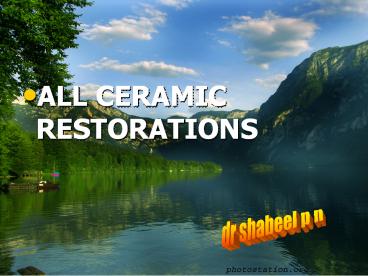ALL CERAMIC RESTORATIONS PowerPoint PPT Presentation
Title: ALL CERAMIC RESTORATIONS
1
- ALL CERAMIC RESTORATIONS
dr shabeel p n
2
Complete ceramic crown
- Should have relatively even thickness
circumferentially - About 1 to 1.5mm thickness needed to create
esthetically pleasing restoration
3
- Advantage
- Superior esthetic
- Excellent translucency
- Good tissue response
- Conservative reduction of facial surface
- Appearance of restoration influenced by color of
luting agent
- Disadvantage
- Reduced strength of restoration
- Significant tooth reduction
- Difficulty in obtaining well fitting margin
- Not effective as retainer for fixed prosthesis
- Wear observed on functional surface of natural
tooth
4
- Indication
- Areas with high esthetic requirement
- Tooth should be relatively intact with sufficient
coronal structure to support the restoration
particularly incisal area - Centric contact must be in an area where
porcelain is supported by tooth structure
- contraindication
- When more concervative restoration can be used
- If occlusal load is unfavourable
Contra
5
Preparation
- Armamentarium
- Narrow round tipped tapered diamond
- Football shaped diamond
- Finishing stones and carbide
- Mirrors and periodontal probe
- Explorer chisels hatchets
- handpiece
6
(No Transcript)
7
Facial reduction
- Placing depth orientation groove
- One depth groove in middle of facial wall and one
each in the mesiofacial and distofacial
trancitional line angle - Depth is 0.8mm to allow finishing
- Cervical component parallel to path of placement
and incisal component parallel to original
contour of the tooth - Reduction is performed on half at a time
8
(No Transcript)
9
Lingual reduction
- Football shaped diamond
- Selected path of placement has been transferred
from cervical wall of facial preparation - Place depth groove in middle of cingulum wall
- Margin should follow free gingival crest
- Should not extent too far subgingivally
10
Chamfer preparation and finishing
- 1mm wide smooth continuous and free of any
irregularity - A 90 degee cavosurface angle is optimal
- Objective is to direct stress parallel to path of
placement - A sloping shoulder result unfavourable loading of
porcelain - Round any remaining sharp line angle to prevent
wedging action
11
(No Transcript)
12
Strengthening mechanism of dental ceramic
- Fabrication defect
- Created during processing
- Consist of voids porosity microcrack
- Surface crack
- Induced by machining
- Flaw effectively determines the fracture
resistance of restoration
13
- Crystalline reinforcement
- Introduction of high proportion of crystalline
phase - A crystalline phase with greater thermal
expansion coefficient produce tangential
compressive stress near crystal matrix interphase - Such tangential stress tends to divert the crack
around particle
14
- Chemical strengthening
- Relies on the exchange of small alkali ions for
larger ion bellow the strain point of ceramic - This techniqe is diffusion driven and its kinetic
are limited by time temperature and ionic radius
of exchanging ions
15
- Stress induced transformation
- Zirconia is monoclinic at room temperature and
tetragonal at 1170 degree - Stress triggers transformation from tetragonal to
monoclinic zirconia - This leads to strengthening as a result of
increase in grain volume in the vicinity of the
crack up
16
- Glazing
- Addition of surface glaze
- The principle is formation of low expansion
surface layer at a high temperature - Self glazing consist of an additional firing in
air after original firing without application of
a low expansion glaze
17
- Prevention of stress corrosion
- Baked on metal foil may reduce fracture incidence
by reducing moisture exposure to internal surface
of ceramic - Coating are used also used to reduce stress
corrosion of glass ceramic
18
(No Transcript)
19
Selection of all ceramic system
- Fracture resistance
- Promising result if the restoration are confined
to lower stress anterior teeth - Esthetic
- A knowledge of available ceramic system is needed
- Marginal adaptation of system is important
- Translucency of adjacent teeth and discoloration
must considered
20
- A more opaque high strength core ceramic system
like inceram or procera are not good choice for
highly translucent teeth - Abrasiveness
- Potential for abration of opposing tooth
particularly in patient with parafunctional habit - Low abration material should be concidered
21
All ceramic partial fixed prosthesis
- Inceram alumina for anterior fdp
- Lithium disilicate heatpressed ceramic empress 2
cad cam procera system are also suitable for
anterior fdp
22
All ceramic foundation restoration
- All ceramic is used as foundation restoration
for endodontically treated teeth to overcome
esthetic problem associated with metal post and
core system
23
Resin bonded ceramic
- Performance of all ceramic restoration has been
enhanced by use of resin bonding
24
- Half moon fracture of crown is common form of
failure it occure in - Teeth with edge to edge occlusion
- When opposing tooth occlude cervical fifth of
lingual surface - Teeth with short crown
- Teeth with overshortened preparation

